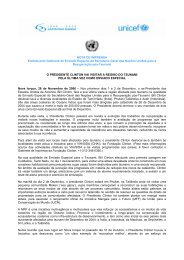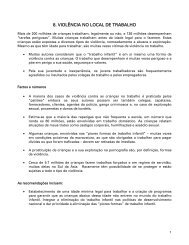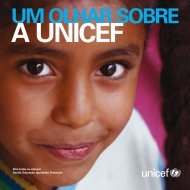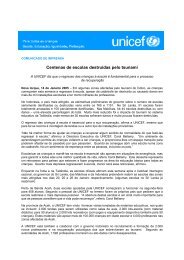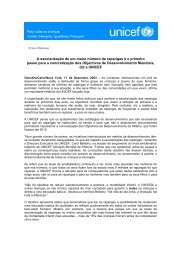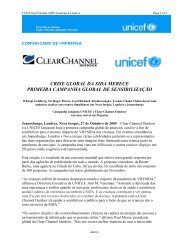Tracking Progress on Child and Maternal Nutrition - Unicef
Tracking Progress on Child and Maternal Nutrition - Unicef
Tracking Progress on Child and Maternal Nutrition - Unicef
You also want an ePaper? Increase the reach of your titles
YUMPU automatically turns print PDFs into web optimized ePapers that Google loves.
Early initiati<strong>on</strong> of breastfeeding<br />
Only 39 per cent of newborns in the developing world<br />
are put to the breast within <strong>on</strong>e hour of birth. The rate is<br />
especially low in Asia, at 31 per cent.<br />
There is growing evidence of the benefi ts to mother <strong>and</strong><br />
child of early initiati<strong>on</strong> of breastfeeding, preferably within<br />
the fi rst hour after birth. Early initiati<strong>on</strong> of breastfeeding<br />
c<strong>on</strong>tributes to reducing overall ne<strong>on</strong>atal mortality. 25 It<br />
ensures that skin-to-skin c<strong>on</strong>tact is made early <strong>on</strong>, an<br />
important factor in preventing hypothermia <strong>and</strong> establishing<br />
the b<strong>on</strong>d between mother <strong>and</strong> child. Early initiati<strong>on</strong><br />
of breastfeeding also reduces a mother’s risk of post-partum<br />
haemorrhage, <strong>on</strong>e of the leading causes of maternal<br />
mortality. Colostrum, the milk produced by the mother<br />
during the fi rst post-partum days, provides protective<br />
antibodies <strong>and</strong> essential nutrients, acting as a fi rst immunizati<strong>on</strong><br />
for newborns, strengthening their immune system<br />
<strong>and</strong> reducing the chances of death in the ne<strong>on</strong>atal period. 26<br />
In a subset of countries with available data, the low<br />
proporti<strong>on</strong>s of early initiati<strong>on</strong> of breastfeeding c<strong>on</strong>trast<br />
with substantially higher proporti<strong>on</strong>s of infants who are<br />
delivered by a skilled health professi<strong>on</strong>al <strong>and</strong> of infants<br />
whose mothers received antenatal care at least <strong>on</strong>ce from<br />
a skilled health professi<strong>on</strong>al. This gap c<strong>on</strong>stitutes a lost<br />
opportunity <strong>and</strong> highlights the critical need to improve the<br />
c<strong>on</strong>tent <strong>and</strong> quality of counselling by health-care providers.<br />
Early initiati<strong>on</strong> of breastfeeding<br />
Percentage of newborns put to the breast within<br />
<strong>on</strong>e hour of delivery<br />
Africa<br />
Asia*<br />
Developing countries*<br />
* Excludes China due to lack of data.<br />
Source: MICS, DHS <strong>and</strong> other nati<strong>on</strong>al surveys, 2003–2008.<br />
26 <str<strong>on</strong>g>Tracking</str<strong>on</strong>g> <str<strong>on</strong>g>Progress</str<strong>on</strong>g> <strong>on</strong> <strong>Child</strong> <strong>and</strong> <strong>Maternal</strong> Nutriti<strong>on</strong><br />
31<br />
39<br />
0% 10% 20% 30% 40% 50% 60%<br />
47<br />
Complementary feeding<br />
In the developing world, 58 per cent of infants aged<br />
6–9 m<strong>on</strong>ths old receive complementary foods while c<strong>on</strong>tinuing<br />
to be breastfed. These data do not refl ect the quality<br />
of the complementary foods received. Meeting minimum<br />
st<strong>and</strong>ards of dietary quality is a challenge in many developing-country<br />
settings, especially in areas where household<br />
food security is poor, <strong>and</strong> it has often not been given<br />
enough emphasis. <strong>Child</strong>ren may not receive complementary<br />
foods at the right age (often either too early or too late), are<br />
not fed frequently enough during the day, or the quality of<br />
the food may be inad equate. New programming opti<strong>on</strong>s are<br />
now available to meet this challenge.<br />
Complementary feeding is the most effective interventi<strong>on</strong><br />
that can signifi cantly reduce stunting during the fi rst two<br />
years of life. 27 A comprehensive programme approach to<br />
improving complementary feeding includes counselling for<br />
caregivers <strong>on</strong> feeding <strong>and</strong> care practices <strong>and</strong> <strong>on</strong> the optimal<br />
use of locally available foods, improving access to quality<br />
foods for poor families through social protecti<strong>on</strong> schemes<br />
<strong>and</strong> safety nets, <strong>and</strong> the provisi<strong>on</strong> of micr<strong>on</strong>utrients <strong>and</strong><br />
fortifi ed food supplements when needed.<br />
Health-system c<strong>on</strong>tacts are not resulting<br />
in early initiati<strong>on</strong> of breastfeeding<br />
Percentage of infants who were put to the breast within<br />
<strong>on</strong>e hour of birth; percentage of births attended by a<br />
skilled health professi<strong>on</strong>al; <strong>and</strong> percentage of pregnant<br />
mothers with at least <strong>on</strong>e antenatal care visit with a skilled<br />
health professi<strong>on</strong>al<br />
80%<br />
60%<br />
40%<br />
20%<br />
0%<br />
47<br />
50<br />
71<br />
Early initiati<strong>on</strong> of breastfeeding<br />
Skilled attendant at delivery<br />
Antenatal care with a skilled professi<strong>on</strong>al<br />
30<br />
Africa Asia Developing<br />
countries<br />
Note: Analysis based <strong>on</strong> a subset of 74 countries with data <strong>on</strong> all three indicators<br />
available from the same survey.<br />
Source: MICS, DHS <strong>and</strong> other nati<strong>on</strong>al surveys, 2003–2008.<br />
49<br />
73<br />
38<br />
54<br />
75



